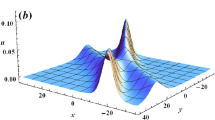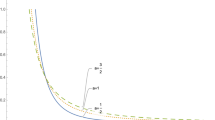Abstract
Whitham’s method of averaged Lagrangian is extended to include dispersive terms on the example of Stokes waves on the surface of a layer of ideal fluid. We derive a Lagrangian with explicit \({\mathcal {A}}_ {x}\overline{\mathcal {A}}_ {x}\) and \( {\mathcal {A}}_ {x}\overline{\mathcal {A}}\) terms partially present in Whitham’s Lagrangian in implicit form in the term with nonlinear frequency, \({\mathcal {A}}\) being the complex-valued amplitude of the wave envelope. The \({\mathcal {A}}_ {x} \overline{\mathcal {A}}_ {x}\) term generates the \(a_x^2\) term in the dispersive part of the Lagrangian, in addition to Whitham’s terms with \(a^2\) and \(a^4\) (\(a\) being the real wave amplitude). The use of complex amplitude of envelope in the averaged Lagrangian allowed us to avoid the introduction of the nonlinear dispersion relation in the Whitham’s method. The variation of the generalized Lagrangian gives the correct evolution equations for the wave envelope and velocity potential.
Similar content being viewed by others
References
Whitham, G.B.: A general approach to linear and non-linear dispersive waves using a Lagrangian. J. Fluid Mech. 22, 273–283 (1965)
Whitham, G.B.: Non-linear dispersion of water waves. J. Fluid Mech. 27, 399–412 (1967)
Whitham, G.B.: Variational methods and applications to water waves. Proc. R. Soc. Lond. A 299, 6–25 (1967)
Whitham, G.B.: Two-timing, variational principles and waves. J. Fluid Mech. 44, 373–395 (1970)
Whitham, G.B.: Linear and Nonlinear Waves. Wiley, New York (1974)
Yuen, H.C., Lake, B.M.: Nonlinear deep water waves: theory and experiment. Phys. Fluids 18, 956–960 (1975)
Yuen, H.C., Lake, B.M.: Non-linear Dynamics of Deep-Water Gravity Waves. Academic Press, New York (1982)
Sedletsky, Y.V.: Addition of dispersive terms to the method of averaged Lagrangian. Phys. Fluids 24, 062105 (2012)
Sedletsky, Y.V.: Dispersive terms in the averaged Lagrangian method. Int. J. Nonlinear Mech. 57, 140–145 (2013)
Hasimoto, H., Ono, H.: Nonlinear modulation of gravity waves. J. Phys. Soc. Jpn. 33, 805–811 (1972)
Nayfeh, A.H.: Nonlinear propagation of wave-packets on fluid interfaces. Trans. ASME Ser. E 43, 584–588 (1976)
Sedletsky, Y.V.: The fourth-order nonlinear Schr ödinger equation for the envelope of Stokes waves on the surface of a finite-depth fluid. JETP 97, 180–193 (2003)
Slunyaev, A.V.: A high-order nonlinear envelope equation for gravity waves in finite-depth water. JETP 101, 926–941 (2005)
Luke, J.C.: A variational principle for a fluid with a free surface. J. Fluid Mech. 27, 395–397 (1967)
Chu, V.H., Mei, C.C.: On slowly-varying Stokes waves. J. Fluid Mech. 41, 873–887 (1970)
Benney, D.J., Roskes, G.J.: Wave instabilities. Stud. Appl. Math. 48, 377–385 (1969)
Davey, A., Stewartson, K.: On three-dimensional packets of surface waves. Proc. R. Soc. Lond. A338, 101–110 (1974)
Babaoglu, G., Eden, A., Erbay, S.: Global existence and nonexistence result for a generalized Davey–Stewartson system. J. Phys. A Math. Gen. 37, 11531–11546 (2004)
Acknowledgments
The author is grateful to Dr. I.S. Gandzha for disinterested and inestimable help.
Author information
Authors and Affiliations
Corresponding author
Appendix
Appendix
The coefficients of equation (25) before averaging over \(\theta _{0}\) are (\(E=\exp i\theta _{0}\))
Note that \(\theta _{0}\) is also present in \(\xi =k_{0}(h+\eta )\), where \(\eta \) is given by Eq. (20).
Rights and permissions
About this article
Cite this article
Sedletsky, Y.V. Inclusion of dispersive terms in the averaged Lagrangian method: turning to the complex amplitude of envelope. Nonlinear Dyn 81, 383–393 (2015). https://doi.org/10.1007/s11071-015-1998-0
Received:
Accepted:
Published:
Issue Date:
DOI: https://doi.org/10.1007/s11071-015-1998-0




